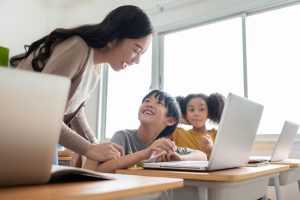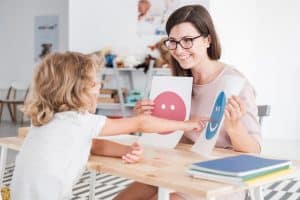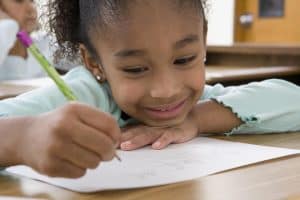 A guest post by Paul Martinez
A guest post by Paul Martinez
Inclusive Curriculum Writer & Editor at Waterford.org
Research shows that children who see themselves reflected in an affirming manner in school curriculum are more likely to experience academic success[1][2]. We also know that children flourish when presented with a curriculum that helps them understand and explore others’ lives and perspectives[3]. With these fundamental understandings in mind, Waterford.org’s Curriculum and Instruction Department is committed to infusing inclusive excellence into our curriculum and materials for children, families, and educators.
We believe that there is great value in ensuring that children see themselves reflected positively in our content. We also want to help children expand their knowledge of the world by allowing them to view and consider life from someone else’s point of view. For these reasons, we strive to ensure that the content we create for children includes stories, images, music, and narration that reflect diverse ethnicities, cultural traditions, abilities, experiences, and family structures.
Building Inclusive Curriculum
The importance of inclusive curriculum is embedded in all we do. We believe that depictions and explorations of diverse experiences shouldn’t be relegated to particular periods of the year or to the occasional themed unit, but rather interwoven throughout each child’s journey through the program. To that end, we include consideration of inclusive excellence when planning and developing each new piece of content.
We also believe that it is important to continuously evaluate existing content with an eye on inclusive excellence. We welcome and encourage feedback from families, educators, partners, and Waterford team members to help us identify shortcomings in our curriculum. In addition, over the past several years we have conducted an audit of our previously created content with the goal of identifying items that fall short of our standards for inclusive excellence.
Through these processes, we have made a number of updates to our content aimed at increasing inclusive excellence. As part of these updates, we work closely with cultural consultants and subject-matter experts to ensure that what we produce is culturally accurate, authentic, and affirming.
Most recently, we partnered with an animation studio to recreate five videos for songs in our curriculum with the purpose of better engaging children and better building inclusivity into the program. Below is more information about each of these videos. We have included a link to each one so that you can enjoy them as we believe children in the program will.
Money
In this song, children learn how to identify pennies, nickels, dimes, and quarters. The original video was set in the Old West and featured three White men counting coins and playing music in a wooden building. In the updated version, a boy and his father who are both Black enter a bank with the boy’s piggy bank full of coins, highlighting his independence in saving up his money. The positive representation of a Black father and his son in the video is important in combating negative stereotypes and promoting positive images of Black fathers and children.
Additionally, the boy in the animation has a prosthetic leg. There are over 2 million Americans with limb differences, and we believe it is important to present these young learners with an opportunity to see themselves positively reflected as well as to provide a space for all children to explore this perspective.
All Sorts of Laundry
This song teaches children about sorting. In order to help young learners better connect with the concept, we replaced the bear that was the central character in the original video with a young boy. In the updated video, the boy is seen sorting and putting away his laundry, again promoting independence. The boy in the new version of the video has vitiligo, an autoimmune disorder that causes patches of skin to lose color. There are an estimated 2 to 5 million people with vitiligo in the United States. Including this representation in our program is important in helping children with vitiligo (and children with loved ones with vitiligo) see themselves reflected positively. This also provides a door for all children to walk through in becoming part of the world crafted in the song.
10 Astronauts
Children learn about the number 10 in this song that takes place in outer space. Whereas the original video for the song included 10 astronauts of the same gender, age, and race, the updated version depicts human astronauts that are a mixture of different genders, ages, and races—along with one very adorable dog astronaut. We believe it is important for children to see depictions of people from diverse backgrounds in positions of esteem and accomplishment.
Mother, Mother, I am Ill
The original video for the song—which teaches rhyme through a fun tale about an ill child who is visited by a doctor, nurse, and quirky woman with an alligator purse—featured a stereotypical White male doctor. In the updated video, the doctor is a woman who is Muslim, accompanied by a male nurse who is Black. In reviewing this song, we felt it was a valuable opportunity to address the historical underrepresentation of such individuals in these roles.
19 Around the World
This song about the number 19 was entirely redone, with an updated musical track that is more upbeat and engaging for children. The video now features a child who is Latina welcoming visitors from the shore on a beach.
Conclusion
When creating and updating early literacy content, we strive to include opportunities for children to both see positive reflections of themselves and explore differing perspectives. These opportunities are important because they not only increase feelings of belonging and engagement but are also linked to increased achievement and academic success.[1][2] Combined with effective instruction grounded in both the science of learning and the science of reading, this approach is part of how we work toward our goal of universal literacy—one of the three pillars of Waterford’s mission.
Learn more about how Waterford’s curriculum can help students see themselves reflected in lessons and consider life from their classmates’ points of view, with an adaptive software that meets every student where they are for personalized support.
References
1. Noguera, P. A. (2003). The trouble with Black boys: The role and influence of environmental and cultural factors on the academic performance of African American males. Urban Education, 38(4), 431–459.
2. Tanya Christ, Ming Ming Chiu, Stephanie Rider, Deborah Kitson, Katherine Hanser, Elizabeth McConnell, Renae Dipzinski & Heather Mayernik (2018) Cultural relevance and informal reading inventory performance: African-American primary and middle school students, Literacy Research and Instruction, 57:2, 117-134, DOI: 10.1080/19388071.2018.1424274.
3. Bishop, Rudine Sims. The Ohio State University. “Mirrors, Windows, and Sliding Glass Doors” originally appeared in Perspectives: Choosing and Using Books for the Classroom. Vol. 6, no. 3. Summer 1990.




